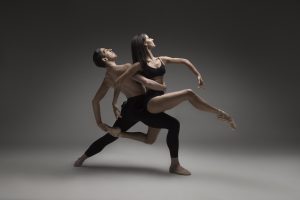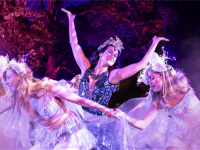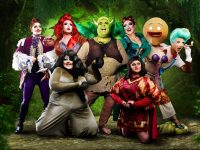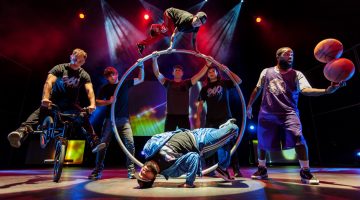
Being & Time – Contemporary Triple Bill
Concourse Theatre, Chatswood
Reviewed by Heather Clements
Melbourne Ballet Company (MBC) occasionally hits the road with its small company of dancers to tour taking their innovative works to regional and interstate areas. Last week saw Chatswood, in Sydney, host the MBC’s world premiere of its 2017 season-opening of a contemporary triple bill Being & Time.
Being & Time marks the MBC’s ten-year anniversary of presenting contemporary ballets of the highest calibre with classically trained dancers utilising their technique and artistry to convey modern-day stories. This Sydney tour was touted to feature two guest dancers – Mara Galeazzi and Joseph Phillips. However, Phillips was unable to perform due to injury.
Being & Time consists of 3 works choreographed by Lucas Jervies, Tim Podesta and MBC artistic director Simon Hoy. The theme of the triple bill has drawn inspiration from the concept of existentialism and the belief that philosophical thinking begins with humans looking at themselves and how they interact with their world – being in the present moment. In other words, the dancers explore themselves as individuals and how their behaviours and emotions fit into their surrounding reality.
The first work of the show was Four Ballet by Lucas Jervies (Australian Ballet, Scapino Ballet, Sydney Dance Company) to the staccato-techno-style music of Adam Ster. With just four dancers in all – Johanna Lee, Francesca Giangrasso, Kristy Lee Denovan and Alexander Baden Bryce – the fast-paced, non-stop movement from and between each dancer was relentless resulting in a work that was continuously fluid and physically demanding. It is heavily anchored in the forms and basics of ballet, which these dancers clearly demonstrated with their abilities throughout.
Jervies says of his work: “Four Ballet is made from and for my love of ballet. Its fast-paced state of apparent emotional catharsis through physical expression is a paradox; it relies utterly on the fundamentals and discipline of the classical ballet techniques and yet is derived from the… emotion.”
The timing and interaction of the dancers is beautifully executed, and the subtle production elements and costumes work to put emphasis on the physicality of the performers and their emotions. Personally, I didn’t like the music of this piece but its repetitive nature served its purpose in the choreography.

Next on the bill was Architecture of Loss by Tim Podesta (South African Ballet Theatre, Queensland Ballet, Projection Dance) featuring headlined guest artist Mara Galeazzi, former principal dancer with the Royal Ballet. It is a nice contrast to the first piece, being far more of a story-telling piece and lovely pas de deuxs between the male and female dancers. The music by Valgier Sigurdsson moves from a simple beat tempo, to piano, to falling rain to soaring strings at the end. The experience of Galeazzi was quite evident, however it would have been nice to see more of her in the piece. Like the music, Architecture of Loss could be described as a little bit ‘schizophrenic’ as it moves through different moods and styles seamlessly. The loneliness of a single dancer standing still on stage for lengths of time was obvious while other dancers performed intricate choreography with each other. Chloe Henderson and Robbie Morecroft were the standouts to me in this work, which was my favourite from Being & Time.
After a brief intermission, the larger company (although small) presented Simon Hoy’s Dasein. Apparently, ‘dasein’ is a German word meaning ‘being there’ or ‘existence’. This was a much more energetic dance piece, set to the strong, techno-rock, beautiful instrumental music of Ben Prunty and Olafur Arnalds. Production wise, after the rather melancholy sets and costumes of the first 2 works, Dasein came out with a bang with dancers in simple black and white fitted costumes and hair out, with a visual projection throughout the whole piece also of black and white repetitive patterns. The visual elements became a performer itself. Luckily, it didn’t cause any dizziness! The notable thing about this piece was that it appeared very ‘concerty’ is its production; like it could have been a 3 minute number! The choreography was made up of unorthodox, strange movements that could only truly be carried-off by well-trained dancers. I thought it started a little loosely, lacking synchronicity but it ended strongly.
According to Hoy, the unusual, random movements in Dasein are a result of “when developing this piece the dancers attempted to explore the ‘authentic being’ through analysing random movement and gesture… the dancers soon emerge into patterns…”
Melbourne Ballet Company has a strong core of 10 dancers, with their individual differences being well-utilised within the company and all dancers to have the opportunity to have their strengths on show.
Next, MBC will take Being & Time to Wodonga on March 17 & 18, and Hawthorn Art Centre on March 29, 30 & 31. This is a great chance for regional communities to see unique Australian-made contemporary ballet.
www.melbourneballetcompany.com.au
Read more about Being & Time here
Read more about Melbourne Ballet Company here













